Interview with Anton Orlov -- An Analog Crusader in the Digital Age
TweetBy Katherine Sweetman
Repost from Reviewer Magazine
Try this: Create a mobile, fully functional photographic darkroom and printing studio then drive it around the country to show the world (starting with the US) that analog photography is not dead! That is what Anton Orlov did this summer.
Ahhh, THE DARKROOM. Do you remember darkrooms? Whatever chaos was happening in the outside world, when I entered a darkroom everything slowed down. The faint humming of a drying fan, the subtle sounds of running water, and the red lights would lull me into a place of calm and quiet meditation. Ok, now mix that darkroom experience with a cross-country road trip. The ups and downs-- adventures and engine trouble, open spaces and strange encounters, the wind in your hair and the stresses of being in a cramped space with your companions. The road trip and the darkroom-- who would think to mash these two experiences into one thing?
Anton Orlov would. And he calls it The Photo Palace Bus.
It's been quite a while since I've had the pleasure of working in a darkroom. In fact, before going to check out The Photo Palace, it had been something like 12 years since I did any printing. All the labs at all the schools that I used to work at have now shut down their darkrooms and traded them in for a single black and white printer. It seemed, to me, that darkrooms had all but disappeared from the face of the earth. Until, that is, I stumbled across this exciting project. The guy has fully converted the interior of a vintage, 35-ft, yellow school bus into a classroom, darkroom, workshop space, and it's mobile. I had the pleasure of interviewing him, Anton Orlov, just after he had returned from a nation-wide, inaugural tour with The Photo Palace, and he's already gearing up to go again as soon as he can afford it.
What follows is an interview with Anton Orlov (AO) Interviewer Katherine Sweetman (KS)
KS Ok, so tell me about the Photo Palace. What is it? Where was it built and, if I may ask, how did you get the funds to build this amazing vehicle?
AO The Photo Palace Bus is a mobile darkroom dedicated to creation and preservation of traditional photographic art. Built inside a California Classic 1978 Gillig school bus, it hosts two-enlarger workspaces capable of producing B&W prints up to 16x20 inches from up to 4x5 inch negatives. The front portion is a presentation area where public can view historic and contemporary handmade photographic works. It's design will eventually allow 3-5 people to travel continually and create art while providing lectures, demos and analogue photography workshops. While originally in 1997 it was just conceptualized as my personal mobile lab, over the years of watching the slow demise of film it became clear that it could be a powerful and greatly needed educational facility.
The first stage of the conversion took place in Santa Cruz mountains at the house of Lee Kalem, an electrical engineer whose son Ryan is, like myself, an alumni of San Jose State University with a photography degree. With Ryan's help and guidance from Lee it took three and a half months of 14-hour days to conclude this first stage. The [second stage] final vision is to be complete as soon as the funding can be made available and will be a second story with two bedroom spaces and a fold-out Portrait Studio on the side of The Bus.
Originally, I was hoping to get part of the construction funded through Kickstarter, but my modest goal of $16K was met only half-way and no funds were transferred. I am very thankful to those donors who chose to re-pledge after the unsuccessful ending of the campaign and transferred a total of $3000 directly through PayPal in exchange for the same rewards that were initially offered. That comprised exactly 10% of the total spent so far on construction. The rest of the funding came directly from my personal savings made over the years while working as a photographer.
On this inaugural journey, I relied heavily on Ryan to provide half the funds needed for diesel in order to cross the country. It was decided that the first trip would be unplanned and uncharted and that we would have just enough money to go around the country, get to know the bus and gather publicity and experience. However, after he decided to leave the project two weeks into the trip, I had to improvise and sell a lot of my photo prints just to make it back to San Diego. After 80 days and 9.300 miles I made it back with a quarter tank of gas left and $37 to my name.
KS Even though your inaugural journey had some speed bumps, you still made an incredible distance, and I imagine you shared the project with tons of folks. Can you tell me where you went and some of the best public engagements experiences you had?
AO The trip started off with a pretty quick drive to Tennessee where this years 41st annual National Rainbow Gathering was taking place. I have been attending and documenting these sub-culture events for the past 15 years, and it was actually at my first one, in 1997, that the idea for a darkroom-bus came to me. There, I gave away about 300 8x10 gelatin silver prints that I had taken at previous gatherings -- as I have done for the past many years. I also engaged a few interested souls in a hands-on workshop involving cyanotype sun prints. The next good exposure opportunity came in Baltimore at this years Artscape event. I sold many prints and had a great time convincing the public that analogue is not dead and that Kodak is a not out of business. During the trip I found myself visiting the town of New Paltz, New York twice because a friend of mine lives not too far from it, and I was able to find a little refuge from the road at her house. The people of New Paltz were very receptive to my art, and I had dozens of visitors come through the bus. There, I also received the first small donation of chemistry and equipment.
I intend on building a large storage area on the roof of the bus behind the bedrooms to be used as a free redistribution center for used darkroom equipment. During my visit to the state of New York I visited the holy grail of all photographic museums -- the George Eastman House Museum of Photography and Film (GEH). It is the oldest photography museum in the world and houses some amazing examples of early analog photographs and equipment. I was fortunate enough to meet Mark Osterman -- the main conservator and instructor of the classes offered through the museum. These classes give the public a chance to learn many, if not all, of the historic photographic processes. Mark gave me a quick tour of the darkroom facility located in the basement of the museum and showed me a few extremely interesting examples of vintage and modern photographic works created via various manual methods. He was a true wealth of knowledge and a delight to talk to. My passion for learning was reignited by the visit to GEH, and in the future I plan on going back there as many times as needed to learn everything that Mark has to teach.
I went to Buffalo, New York and tried my best to raise the necessary funds to take an ambrotype workshop, which happened to be offered in three days. In the next two days I only raised about 60% of the funds needed, but fortunately, I happened to meet Rob McElroy -- a modern-day daguerreotypist [see: daguerreotype] and a true analog and history enthusiast. Our meeting sticks out in my memory as one of the brightest highlights of the entire trip, and it also provided the opportunity for the learning experience of a lifetime.
During our first meeting we spent nearly 9 hours in his studio, study and garage with every moment filled by Rob pulling out some obscure piece of photographic history from the stacked flat-files or camera-filled boxes. I was amazed and enchanted after holding in my own hands such relics as photogravure-filled volumes of Camera Notes magazines, full-plate autochrome plates, fantastic daguerreotypes and many more objects about the existence of which I have only read in art history books.
My second visit to Robs involved something I could have only dreamed of -- a complete demonstration of the making of a daguerreotype image with The Photo Palace Bus and me as subjects!
This high honor was completely unforeseen, and I am eternally grateful for that fantastic opportunity and Rob's magnanimous generosity in presenting me with one of the two resulting daguerreotypes. I spent a total of 11 hours watching over his shoulder as he went through every step involved in making a photograph using this historic method. From polishing and sensitizing the plate to mercury-fume development and framing the final image Robs love for the photographic craft was evident through his meticulous attention to detail and clear in-depth explanations of every step of the process. This is the second of the two frames that Rob produced from our photo session and the one he kept for his collection. Daguerreotype emulsion is the slowest emulsion of them all, and I had to hold this pose for one whole minute. As soon as financially possible I would love to make my way back there and take a full workshop in daguerrean photography from Rob McElroy, and I encourage everyone interested in contacting him for a workshop or a portrait session of their own as he is a true pleasure to work with.
Salem, MA saw the bus parked on a pedestrian promenade in front of Peabody Essex Museum where a beautiful collection of prints by Ansel Adams was on exhibit. I convinced museum staff to let me park Gilli [the name of the bus] there and give the interested public an idea of the environment where Ansel created his silver prints that they just viewed.
My arrival to Portland, ME luckily coincided with an art-walk event there and again I had droves of onlookers come through The Palace, and a lot of them walked away with some of my prints in hand.
Providence, RI saw me doing a little lecture to a group of high school students through New Urban Arts -- an organization committed to providing after-school arts education. Here is a link to a video. [by Providence Journal]
Another good opportunity presented itself serendipitously in Topeka, KS. I was approached to do a photography workshop through The Villages Inc. -- a place where troubled youth is rehabilitating outside the juvenile courts system. I had four students who experienced the joy of developing and printing black and white images by hand and walked away with 8x10 prints of their own portraits.
The rest of the time I was pretty much guerrilla marketing myself in various towns desperately trying to keep the tank full of gas and making documentary images during my spare time. I visited quite a few camera shops along the way and was warmly received in all of them. Many store owners also bought some of my art and some just contributed donations large and small out of pure goodness of their hearts. I was also overjoyed three times during the trip by having people recognize The Photo Palace Bus from having seen it on Kickstarter 7-8 months ago. Their enthusiasm and sense of incredulity had greatly helped buoy my spirits.
KS Ok, so, In an age of digital, digital, digital, why do you feel its so important to keep these analogue photography techniques alive?
AO The trend of faster plus cheaper plus easier equals better is bothersome to me. I personally feel that investment on the part of the artist of their patience and skill is important, and in the end it speaks through their final piece of art. When I see a finely produced gum bichromate or a gelatin silver print, I know that a certain human being was behind its creation, putting time and effort into that particular tangible object. Do you think Rodin would have worked on 3-D printers? Do you think Rafael would have used Adobe Suite? Would their works withstand the test of times as well if they did? I don't think so. Today billions of images are created daily, a vast majority of them with little or no thought. In years to come - who will value this onslaught of media? Who will take time to go though all the Flikr, Tumbler, Photobucket etc? A Renoir painting was recently bought as a lot at a flee market for $50 - it is worth over $100K. That work is unique and tactile. It withstood the test of time because of those qualities, and I know that every print I make will be there, appreciated or not, for generations after I am gone from the face of this planet. I also think that a certain level of conviction and dedication is asked of an artist when they decide to make even a simple gelatin silver print. I would hate to see that aspect of art get lost in lieu of mass produced images inundating our reality today. Every image that I produce is TOUCHED by me - that's what matters most. When it hangs on the wall of the home of someone who bought it, a part of ME hangs there with it. I think that's the most important point that makes me continue spending countless hours in the red ambiance of the darkroom.
I have seen multiple companies with a slew of wonderful products go under the digital hammer, and I would like to see, at least those that are left, offering artists of the future an opportunity to create something with their own two hands. The technology behind some of techniques of the olden days is now so far gone that people can not reproduce it no matter how hard they try. Thanks to Rob McElroy I was lucky enough to hold in my hands a few Autochrome plates during this journey. Their intrinsic beauty struck me to my core - the look is absolutely unique and every image is a singular work of art. I understand that a very rich man in Texas has been desperately trying for the past many years to revive this technology, with no success at all. The technique of Bromoil printing all but disappeared in the 50s-70s, only to be revived slightly during the 90s, but now is in danger of becoming completely extinct because bromide papers are no longer manufactured. Look at Polaroid. For years people didn't think twice about the chemical magic that went into each and every image. The Polaroid color pallet is so unique and wonderful that today people, who are used to seeing hundreds of images a day on the screens of their computers and mobile devices, are astonished and enchanted when they are confronted with a real Polaroid SX-70 image. Now it's turned into a hipster fad led by The Impossible Project -- a company with an extremely savvy advertizing department, yet struggling to come up with a single decent product that can come close in comparison to the original Polaroid quality. By god, I hope Fuji doesn't stop making their instant films -- though they have a completely different presence than the old Polaroid films, they still offer the permanency of those films and at least some instant fun with decent results.
KS I know you are still recovering, but what's in the future for the Photo Palace? If money was no object, what would you do with it and where would you go?
AO If I found a sponsor and money was no object at all, I would continually travel the US providing first-hand opportunities of learning about the rich history of photography to middle and high school students-- offering printing workshops myself as well as hosting other artist that work with techniques that I am not familiar with. I would get the second level [second story of the bus] complete for a crew of a couple of helpers who would be in charge of logistics. I would redistribute photographic equipment and help people and organizations set up their own darkrooms. I can't tell you how many times I've been offered a free darkroom set during this journey and then in the next town I meet someone who can't afford to get one but would love to. I would get the studio set up and provide portraiture workshops using various cameras and natural lighting styles. That studio would also be used to create an egalitarian cross-cultural portrait series with free prints provided for anyone who stepped within its bounds. And THE BIG ONE - I call this "My 2020 Vision" - by the year 2020 I would love to have enough experience and financial backing to take Gilli around the world -- up to Alaska and across the Bering Straight to Russia, China, India and on and on to Europe. I have had some really warm response so far from the European arts community, and I'd love to give them a pleasure of seeing this baby roll down their streets.
For now, I am looking for an administrative helper -- truly inspired artists I know are not the best self-promoters and tend to be shy and reclusive. I am looking into a possibility of establishing a non-profit for The Photo Palace so large grants would be easier to apply for. But, really, I would love to have continuing sponsorship from companies dedicated to analog photography such as Freestyle, Photographers' Formulary or some larger artistic venues, like Getty or ICP or NYMOMA --- I can dream right?. So all we'd have to do is worry about finding new interested audiences and providing them with engaging material and not have to constantly think about how we (me and my imaginary crew) can fund this whole thing.
By myself I am hoping to organize the next trip to start in a couple of months (or sooner if something good happens) and take it MUCH slower. This trip would be just around California (it's warm in the winter here) and would last for a few months until I can go East via the South. Actually, if money wasn't a problem I would do the exact same thing, but I would be able to PAY someone to join me and would not have to rely on finding a volunteer as crazy as I am.
KS What can people do to find out more about The Photo Palace, where it will be, how they can get in on some workshops, and find out more info about you and your work? AO You can check the blog http://thephotopalace.blogspot.com/ to see what's happening, read about the conversion process, and hear of the trials and tribulations of the first cross-country trip. Everyone is welcome to befriend me or Photo Palace Bus on Facebook and follow us on twitter--@thephotopalace. They can send me direct e-mails to thephotopalace@gmail.com as well as my personal photo website (which is desperate need of updating) with a 100% analogue work is orlovphoto.com
KS In closing, I want to say that interested parties can contact Anton Orlov about photography classes on the bus and as well as in a more traditional darkroom environment in North Park area. Classes and Workshops available. Donations can also be made to the Photo palace Bus project at http://thephotopalace.blogspot.com /p/donate.html
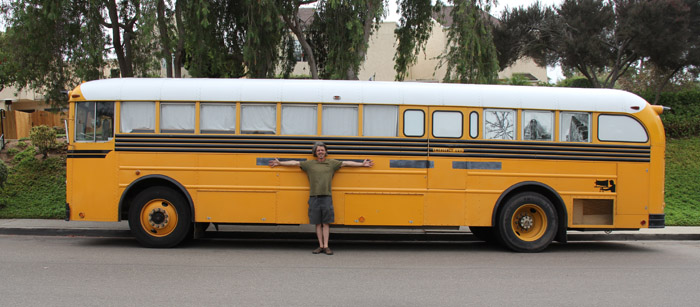
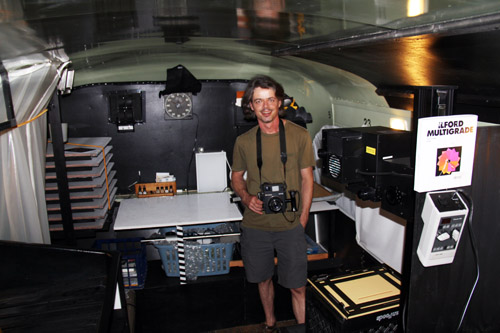
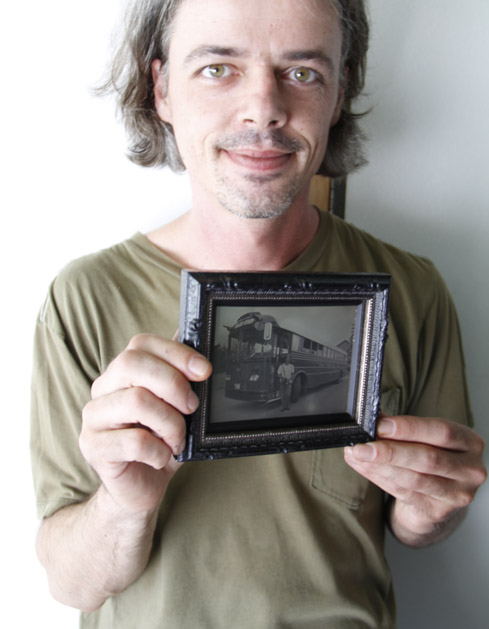
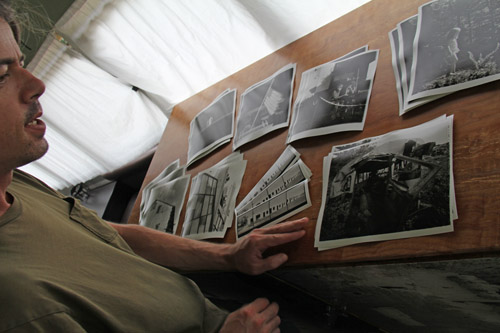
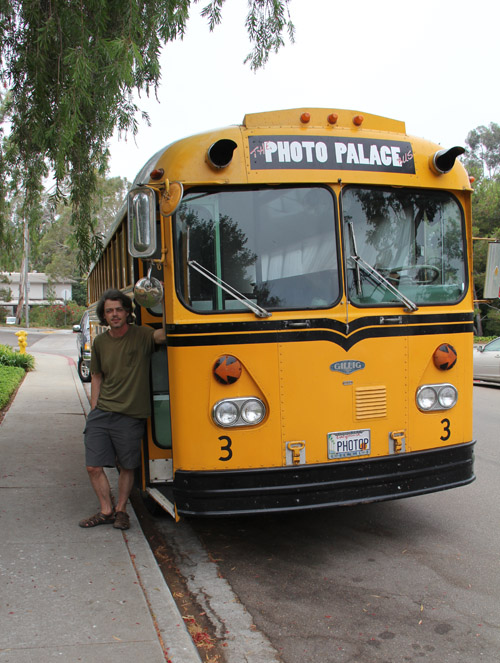
No comments:
Post a Comment